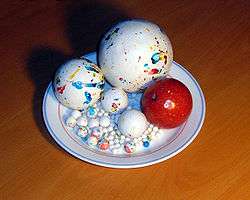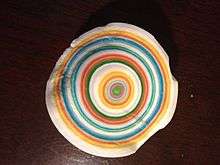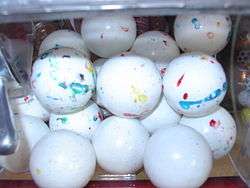Gobstopper
Gobstoppers or jawbreakers are a type of hard candy. They are usually round, and usually range from 1 to 3 cm (0.4 to 1.2 in) across; though gobstoppers can be up to 8 cm (3.1 in) in diameter.
 Gobstoppers of various sizes and colors. The largest one is 3 inches (~7.5 cm) in diameter | |
| Alternative names | Jawbreakers, Jaw Busters |
|---|---|
| Type | Confectionery |
| Place of origin | United Kingdom |
| Main ingredients | Sugar |
The term gobstopper derives from "gob", which is slang in the United Kingdom and Ireland for mouth. The sweet was a favourite among British schoolboys between World War I and World War II.[1] In his 1964 children's book Charlie and the Chocolate Factory, British author Roald Dahl described "Everlasting Gobstoppers", a fictional type of gobstopper that could never get smaller or be finished.
Gobstoppers usually consist of a number of layers, each layer dissolving to reveal a differently coloured (and sometimes differently flavoured) layer, before dissolving completely. Gobstoppers are too hard to bite without risking dental damage (hence the name "jawbreaker").
Gobstoppers have been sold in traditional sweet shops for at least a century, often sold by weight from jars. As gobstoppers dissolve very slowly, they last a very long time in the mouth, which is a major factor in their enduring popularity with children. Larger ones can take days or even weeks to fully dissolve.
Manufacture

Gobstoppers are made by slowly depositing layers onto a core (such as a pressed ball of sugar or a gumball[2]). Gobstoppers are made in large, rotating, heated pans. This is called "hot panning". The candies take several weeks to manufacture, as the process of adding liquid sugar is repeated multiple times. Natural and artificial colours and flavours are also added during the panning process.
Everlasting Gobstoppers
The Everlasting Gobstoppers, sold under Nestlé's Willy Wonka Candy Company brand, were first introduced in 1976 by Breaker Confections,[3] and are named after the Everlasting Gobstoppers in Roald Dahl's children's book Charlie and the Chocolate Factory. In Dahl's story, Everlasting Gobstoppers are purported to last forever. Dahl named the sweet after Gobstoppers, which were a favourite among British schoolboys between the two World Wars.[1]
Notable incidents

In 2003, Taquandra Diggs, a nine-year-old girl in Starke, Florida, suffered severe burns, allegedly from biting on an exploding Wonka Everlasting Gobstopper that had been refrigerated, left out in the sun, then refrigerated again. Diggs and several other alleged victims' families filed lawsuits against Nestlé for medical bills resulting from plastic surgery as well as pain and suffering; the matters were later settled outside of court for an undisclosed amount.[4][5]
See also
- Aniseed ball
- Atomic Fireball
- Ed, Edd n Eddy
- Humbug
- Lemonheads
References
- John Ayto (2012). The Diner's Dictionary: Word Origins of Food and Drink. p. 154. Oxford University Press.
- How it's Made Season 7 Episode 02
- Zeldes, Leah A. (October 30, 2009). "Willy Wonka lives in Chicagoland". Dining Chicago. Chicago's Restaurant & Entertainment Guide, Inc. Archived from the original on November 4, 2009. Retrieved November 4, 2009.
- "Florida Girl Injured In Bizarre Candy Episode". The Smoking Gun. 2011. Archived from the original on February 13, 2011. Retrieved February 21, 2011.
- "Jawbreaker Candy Explodes, Burns Fla. Girl's Face". WKMG Orlando. 2011. Archived from the original on August 11, 2011. Retrieved February 21, 2011.
External links
| Wikimedia Commons has media related to Gobstoppers. |
- Police report on Taquandra Diggs' exploding gobstopper (thesmokinggun.com)